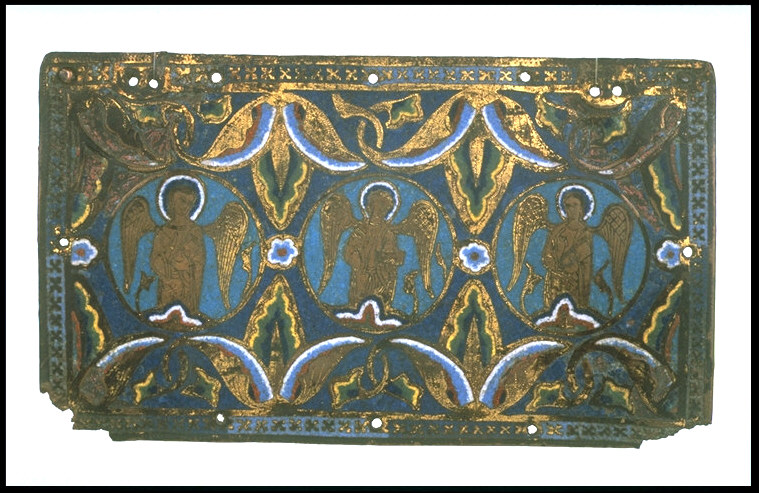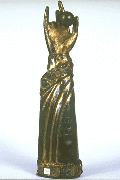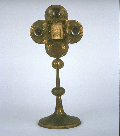An Introduction to Limoge Champlevée Enamelware Techniques
Arenwald von Hagenburg

Introduction
Limoge enamelware is a definition applied to a distinctive style
of champlevée (fr. "raised ground") enammeling technique
almost exclusively practiced in the French town on Limoge from
the 12 century to the 15th century[1].
The style is considered to have reached its zenith in terms
of style and sophistication early in the 14th century.
Due to the extrordinarily high quality of the products of Limoge artifacts
manufactured by its artisans were widely prized and recognised.
The result was a burgeoning market and a wide connaissance of
the style, culminating (rather naturally) in inferior attempts
at reproduction of the style in other locations.
However true Limoge enamel is characterised by its exquisite
gravure, and superlative deliniation of figures and semi-ronde figures.
Ably supplemented by a unique style of enamel colouration, in which
the enamel is applied in concentric lines without the divisions
(cloisons) normally used to separate pigments and prevent them
diffusing into one another. In fact it is precisely the controlled
use of the
diffusion of coloured glasses into each other that makes
the "ouvre" of Limoge so unique and distinctive amongst enamels of
the period.
Archaelogical Data
The work practices and construction techniques employed in the
construction of Limoge enamels have (rather unsurprisingly) been
a focus of investigation of the Musée du Louvre[Biro95].
Some recent exhibitions and publications reveal a wealth of
interesting information on construction techniques, modes of
use, and variations in production methods and types of enamels
employed as well as chronicalling the evolution of the
artistic style in the Limoge ateliers (workshops).
Regrettably many of those publications are in French and
are not immediately accessable to those without a reasonable
working grasp of the French language.
Consequently it seems apposite to provide an elementary overview
in the remainder of this section.
All limoge enamel work in the period from the 11th to 14th
century is based on taking an object (normally of brass
or copper) and excavating some of the material to provide areas in which
enamels can be placed. The basic idea being to fill these areas with enamel
and grind off the surplus to give a smooth surface in which enamel is
used to add highlights and colour to the overall design.
Later works include low-relief (ronde-bosse) cast additions
to add more life and depth to the works, or the basic
material is raised using repousée work.
In some examples shortcuts are evident when the pieces are subjected to
X-ray and other examination processes[Brio95].
In some notable cases the process of engraving the cloissons (enclosures)
into which the enamel was to be placed must have been considered too laborious
and so an outline of the shape required was constructed by
cutting an outline from one plate, and soldering this to a backing plate.
Fine details were then added using the cloisonée technique.
This is apparent when the pieces are removed from the mountings
and solder lines can be seen. In addition the use of cloison work can be
deduced due to the fine nature of the divisions between the areas of enamel.
Overview of Technique
The basic order of construction of an enamel consists of
the following sequence.
Design and laying out the design, engraving and excavation of
the areas that are to be filled with enamel, filling in with
enamels, baking the piece to fuse the enamel, followed
by grinding and polishing. Finally surface engraving is used to
add details to figures and scrollwork or acanthus decoration to
backgrounds.
Rather than provide a repetitive coverage of enamel construction
the construction page for
Limoge enamel [Limoge] is suggested
the loose translations from the French that are
included on the local version of the page
are my own work and I take responsibility for the errors
and mis-translations that appear there.
Use and Significance
The use of enamel decoration of objects extends to both the sacred
and profane. By far the greatest collection of extant objects are
in sacred collections and include

| 
| 
|
| coffers,
| reliquaries,
| monstrances,
|
and a range of other items of religious significance.
Reproduction
Reproduction of this type of enamel is not necessarily a matter
for the expert, nor should it require technical equipment much beyond
the scope of the modern kitchen.
Concluding Remarks
I have attempted to provide a basic overview of the methods and
usage of enamelling techniques in the Limoge region of France
between the 12th and 14th centuries when the skill and fame of
the region was at its height.
The later definition of "Limoge Enamel" as highly realistic painting
in enamels dates from the 17th century and is outside the scope of
SCA re-enactment.
Technical Glossary
champleve - raised ground, a technique where parts of the metal being
enammeled are removed and enamel placed into the spaces created.
cloissone - enclosures, a technique where small cells to hold enamel are
created by
References
[Biro95] I. Biron, "Recettes Médévales des Émailleurs
Limousins", In Les Émaux de Limoges au Moyen Age,
Dossier de L'Art, No 26, Nov-Dec 1995.
[Limoge] The web site of Limoge Enamel, http://www.culture.fr/emolimo/
The site credits for contributions are extensive and
deserve recognition.
Author Biography
Arenwald von Hagenburg is the SCA role character of
Arnold Pears BSc(Hons), PhD, a senior lecturer in computer science
with an interest in historical reenactment and associated research.
Dr Pears has been involved in reenacment activities with a variety of
societies since 1984 working primarily with art and craft
reproductions. His major areas of interest include
cabinet-making, choral and solo singing, dance, fencing,
late 15th century and rennaissance clothing, cobbling,
tentmaking and jewelery.
His achievements and sharing of knowledge in a range of areas have
been recognised by the Society for Creative Anachronism (SCA)
by the conferal of that society's highest award for artistic
endeavours (The Order of the Laurel). He is currently resident in
Uppsala, Sweden, where he works for the Department of Computer Systems
at the University of Uppsala. People wishing to contact the
author should email
arnoldp@docs.uu.se






